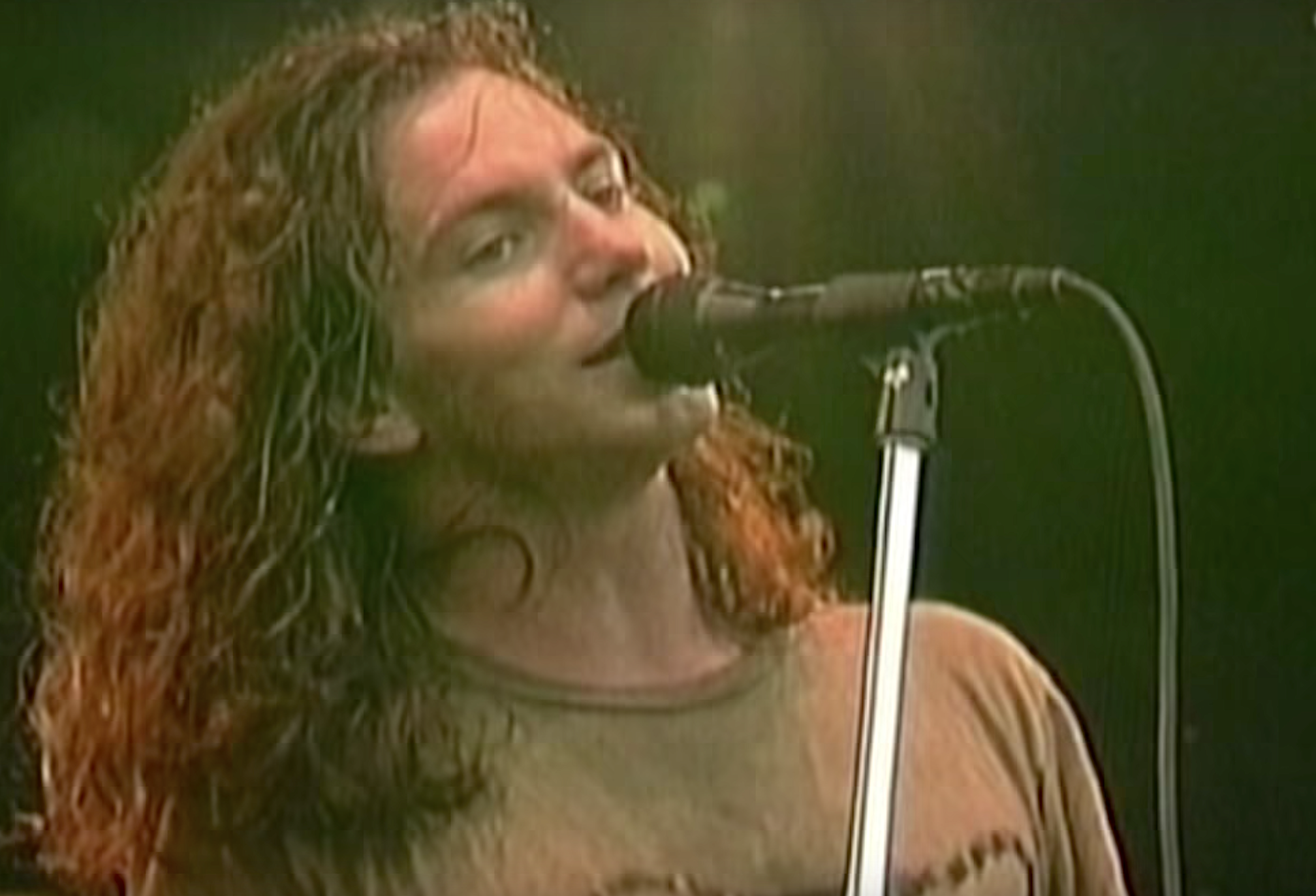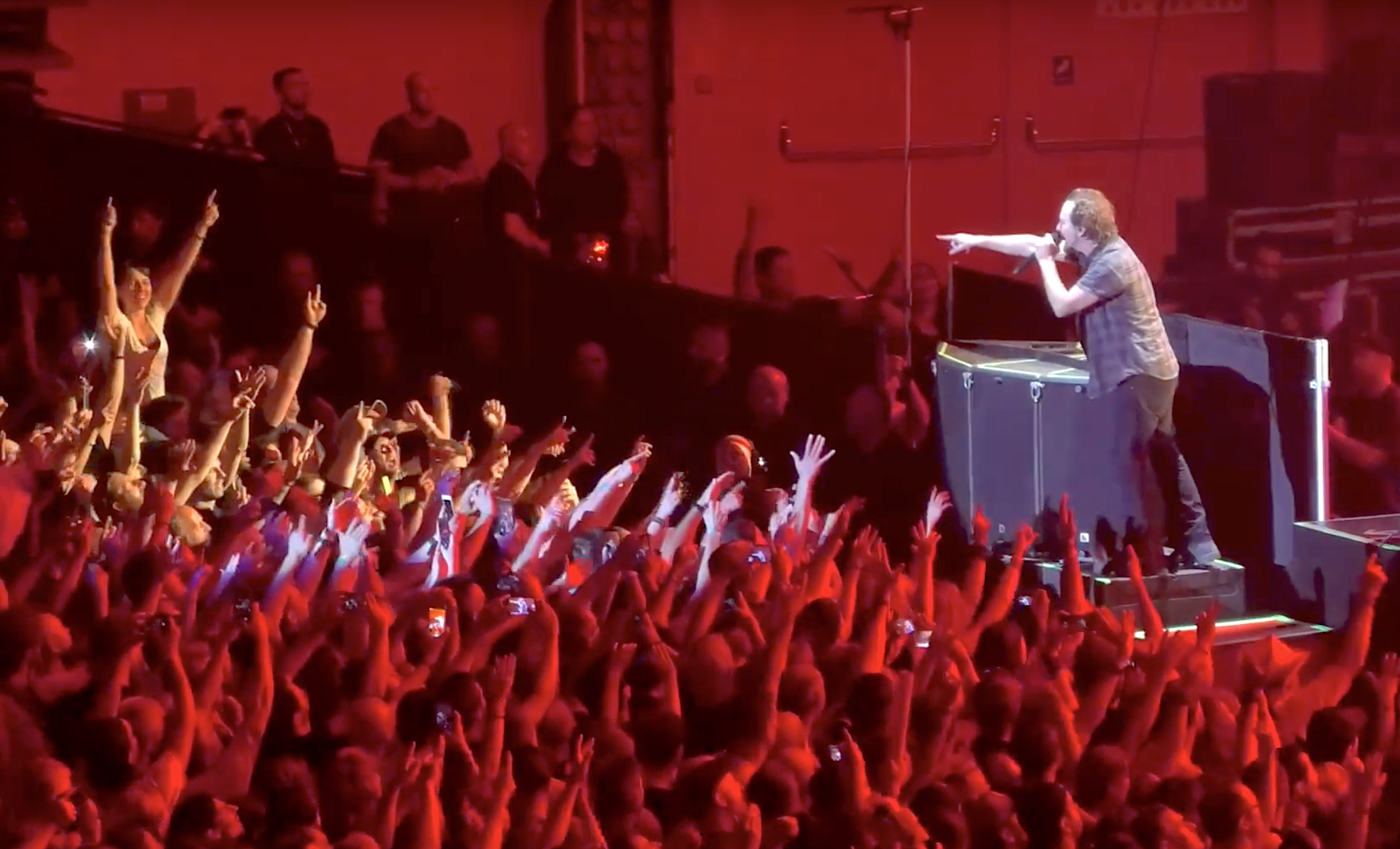
What a life Pearl Jam?s ?Alive? has lived since it was released on July 7, 1991. Since then, the band has played the song live 763 times, according to PJStatTracker ? and 770 times in all (as of this writing), including the in-concert performances prior to the song?s release. But the story of ?Alive,? the very first song in the Pearl Jam catalog, goes back further than July 7, 1991.
From the iconic first notes of the song?s soaring guitar riff to its anthemic chorus to its rock god-inspired solo to the last second of its trash can ending, Pearl Jam?s 1991 song ?Alive? is pure and true rock and roll ? in some ways unlike any other song in rock and roll history, but in others a lot like some of the great songs that came before it. One of the most influential grunge songs of the nineties and one of the great rock songs of all time also has a remarkable story behind it.
Like the actual experience of listening to ?Alive,? every plot detail behind the song?s emergence ? the twists of fate, the influences, the lore ? is something at which to marvel. This is a story that?s been told in bits and pieces before. But 28 years after the song arrived, first as a single and then as the third track on Ten when the album was released on August 27, 1991, now is as good a time as any to reflect on it.
The Demo
The story of ?Alive? begins with another title, another Seattle band, and a four-and-a-half-minute demo. Though the song is synonymous with the 1990s, its music dates all the way back to the 1980s, well before the Seattle Sound took over rock radio and MTV.
Stone Gossard wrote the music for the song, punctuated by that instantly-recognizable opening guitar riff, in the late 1980s as a member of the up-and-coming band Mother Love Bone. He originally titled it ?Dollar Short? and Gossard reportedly has said Mother Love Bone even played it live on one occasion.
 Pearl Jam guitarist Stone Gossard.
Pearl Jam guitarist Stone Gossard.
Like the lyrics that helped make it famous, the song was born out of sadness and pain. In 1990, Andrew Wood, Mother Love Bone?s singer, died after suffering a heroin overdose. The band, teetering on the cusp of rock stardom, was over.
Reeling and looking for a new way forward, Gossard summoned his Mother Love Bone bandmate, bass player Jeff Ament, and a new guitarist named Mike McCready to record an instrumental demo of ?Dollar Short? along with a handful of other songs.
Gossard also recruited Soundgarden drummer Matt Cameron to help out on the demo. More than a decade later, Cameron became Pearl Jam?s fifth drummer, a post he still holds today ? another of the remarkable twists of fate along the song?s path to rock immortality.
What?s so amazing about the recording those four guys put down on tape is how much the instrumental song on that demo sounds like the final radio version that helped catapult Pearl Jam to the top of the music world. Yeah, the trash can ending still wasn?t a thing yet and McCready?s solo had yet to come to life the way fans know and love it now. But for a demo on a cassette tape, ?Dollar Short? was pretty awesome. That song was ready. Listen to it below.
All it needed was some worthy vocals.
Not long after the demo was finished, another well-known drummer figured prominently in the birth of ?Alive? ? a drummer who years later became Pearl Jam?s fourth percussionist. Jack Irons, a founding member of the Red Hot Chili Peppers, was playing drums for another band, Eleven, at the time, and passed a tape of the ?Dollar Short? demo and two other songs onto a friend, a singer named Eddie Vedder who fronted the San Diego-based band Bad Radio.
Vedder listened to the tape and, inspired, went surfing as he was wont to do. Riding the waves where they took him that day, Vedder conjured up some lyrics while on his surfboard and promptly wrote them down afterward. Then he recorded himself singing the lyrics over the ?Dollar Short? demo. He also recorded vocals for demos that eventually became ?Once,? the opening song on Ten, and ?Footsteps,? a Ten-era B-side. The trio of songs went on to become known as the ?Momma-Son? trilogy and figured prominently in the making of the band?s first album.
The result, particularly on ?Alive,? was nothing short of astonishing, especially since Vedder had never even met the musicians who recorded the music for the demo. This songwriting process is something Pearl Jam has never outgrown and still used to powerful effect on its most recent album, following a similar method for the writing of?Sirens,? the second single from the 2013 album Lightning Bolt.
Vedder sent the tape back to Seattle, the note ?For Stone + Jeff? written in marker across the top of the white cassette body.
The lyrics, the melody and of course Vedder?s booming baritone all sound remarkably like the song that showed up on Ten, the band?s first album, in a matter of months. An instant hit, really. Listen below.
?Without even knowing these guys, we kind of wrote music together,? Vedder told Jessica Letkemann for her 2010 book Music For Rhinos: The Making of Pearl Jam. ?It was this cool, little mini-opera.?
Gossard and Ament agreed that something special was brewing after listening to the tape that was sent back to them and invited Vedder to join them for some rehearsal sessions in Seattle. The band just clicked. This was the way forward Gossard had been looking for. Years later, Vedder said of ?Alive,? it ?was the first song we ever wrote as a group.?
The solo from the gods
What?s missing from the completed demo is something that became a hallmark of the album version of the song, and a particular high point during live performances: Mike McCready?s epic guitar solo.
But what about that solo makes it so compelling? There?s the obvious: It?s an exhilarating piece of music played with searing emotion that comes about two-thirds of the way into the song right after the chorus and on the heels of a series of ?yeahs? from Eddie Vedder.
Is there something more, though, that makes this guitar solo so great? Did it come from somewhere else? Another place, another time? Did the rock and roll gods themselves come down from on high and manipulate McCready?s fingers up and down the fretboard to hit, bend and hammer on all the right notes in a precise and perfect instrumental outburst rooted in the great pantheon of rock?
Well, yeah, actually. That?s kind of what happened. Rock gods did have a pivotal effect on McCready when he recorded that solo at a studio in Surrey, England.
?Basically, I copied Ace Frehley?s solo from ?She,?? McCready once admitted to Guitar World, referring to the lead guitarist of KISS. The ?Alive? solo was named 44th best on Guitar World?s list of The 100 Greatest Guitarists of All Time. ?Which, of course, was copied from Robby Krieger?s solo in the Doors? ?Five to One?,? McCready added.
?She? was released in 1975, on KISS?s Dressed to Kill album, and the band and the song had a lasting impact on a young Mike McCready.
?Ace was their firecracker, their dynamite. He?s what took them over the top with the feel he put into his leads. I really gravitated towards his vibrato,? McCready recalled in a piece for Rolling Stone in 2014.
So when it came time to record the solo for ?Alive? 16 years later, ?I thought about it like, ?I?m going to approach this like Ace did on ?She?,? he explained. What he didn?t realize is that Frehley was a huge Doors fan and when the KISS guitarist was looking for an approach as he recorded the ?She? solo, he turned to Krieger?s ?Five to One,? a deep cut from The Doors 1968 album Waiting for the Sun, for inspiration.
Frehley summed up the passing on of a solo through the rock ages. ?I steal from someone and then they steal from me and so on,? Frehley told Sleaze Roxx in a 2008 interview. ?That?s what rock ?n? roll does. It all goes back to the records from the ?50s and ?60s.?
Watch the video below to hear all three solos in sequential order. It serves as an emblem of how the gods of rock pass down the tradition, and it also shows the heights to which McCready took the solo.
Of course, that?s not the only solo in ?Alive.? Another one comes along that leads into the trash can ending and it might be bigger and better, as McCready, seemingly bubbling over with music in his body, plays every single note that needs to be played for ?Alive? to be complete.
?The curse?
From the beginning, ?Alive? had all of the hallmarks of an anthem, perhaps most significantly because of its unflinching, life-affirming chorus. And that?s how the song was received. Audiences interpreted ?Alive? as a bastion of hopefulness. But at their core the song?s lyrics are dark. Themes of parental deception, family dysfunction, death, and even incest emerge, some of which were drawn from Vedder?s own life experiences.
It is heavy stuff, to be sure. And, though the song was wildly popular with Pearl Jam fans, due to the personal nature of the material, Vedder became weary of performing it live. But over the years, the audience?s interpretation of ?Alive? changed Vedder?s own interpretation of the song. He talked about it in 2006 when Pearl Jam appeared on an episode of VH1?s Storytellers.
 The cover of Pearl Jam?s 1991 single ?Alive.?
The cover of Pearl Jam?s 1991 single ?Alive.?
?The original story being told in the song is that of a young man being made aware of some shocking truths,? Vedder explained to the Storytellers audience. ?One was that the guy he believed to be his father while growing up was not. And hard truth number two was that the real father had passed away a few years before ? as if adolescence wasn?t tough enough,? he said coaxing a few laughs from the hushed crowd.
Vedder went on to say that living through the traumatic experience left him feeling confused, and added that his teenage self took ?all of this news as a curse.? Trying to find a way forward, Vedder explained of his younger self, is the origin of the iconic chorus.
?Fine, the dad is dead ? but I?m still alive and I gotta deal with this,? the singer revealed.
Vedder opened up about how the larger the audiences Pearl Jam played in front of became, the more the strong reaction to the song?s chorus surprised him. ?Folks are jumping down in the aisles and using their bodies to express themselves, and belting it out ? singing along.?
Looking out on audiences night after night and seeing this sanguine interpretation had a profound effect on Vedder, he said.
?The audience changed the meaning of these words. And when they sing ?I?m still alive,? ya know, it?s like they?re celebrating. And here?s the thing: When they changed the meaning of those words,? Vedder continued, pausing, ?they lifted the curse.?
The lore
Not everything about ?Alive? is so weighty. In fact, what would a song as great as ?Alive? be without some fantastic folklore? According to Eddie Vedder, the band once turned down a handsome sum of money to allow ?Alive? to be used in a TV commercial. During a 2003 concert in San Diego, Vedder told the audience a ?ridiculous? story about his fascination with the singer-songwriter Jewel.
He confessed to the crowd that he was anticipating her next album ?so highly, I can barely think of anything else.? He continued, ?When I mess up a lyric ? it?s because I just can?t wait for this new Jewel record to come out, ya see. It?s an obsession.?
Vedder explained that Jewel?s hit new single at the time, ?Intuition,? was featured in a TV commercial for Schick?s Intuition line of women?s razors before the song was officially released. ?I don?t even have to download anything,? he deadpanned. ?I just have to watch TV and wait for the commercial.?
The Jewel anecdote jogged Vedder?s memory of some offers Pearl Jam received to license the rights to songs for a TV commercial. ?It reminded me of this offer that we turned down. The best one we got was from Viagra,? he said.
 Eddie Vedder interacts with the audience during a 2018 performance of ?Alive? at Tauron Arena in Krakw, Poland. Watch it below.
Eddie Vedder interacts with the audience during a 2018 performance of ?Alive? at Tauron Arena in Krakw, Poland. Watch it below.
?They showed us these little storyboards,? he went on, saying the idea for the commercial was to show an illustration of a phallus that was singing, ?I?m still alive.? The audience erupted in laughter and cheers at the revelation.
?Six million dollars we turned down,? Vedder claimed, so Pearl Jam could ensure that ?Alive? would not appear in the Viagra ad. The revelation drew more laughter and applause from the audience, not to mention a grin from Vedder.
It?s not clear whether Vedder was joking, and the story is so good it may not be worth investigating whether there is any truth to the claim. Why ruin it?
?We?re all still alive?
Seven-hundred-seventy times. Aside from ?Even Flow,? which has been played live a whopping 836 times, the band has performed ?Alive? more than any other song in the Pearl Jam catalog. It?s a staple and at this point in Pearl Jam?s career, the band probably couldn?t get away with not playing the song without inciting a riot. Typically, ?Alive? happens near the end of the show, one of the last three or for songs before the concert is closed out.
In a nod to how the audience changed the meaning of the song for Vedder, he often implores the crowd, ?Look at us ? we?re all still aliiiiive,? just before McCready plunges into his first guitar solo. It?s not just Vedder who?s experience with the song has been profound, though. Many Pearl Jam fans have found the song to be transformative, which is clear in the way live audiences nearly 30 years later still respond to the song.
And if fans? reactions to the song in concert aren?t enough of a sign as to the lasting effect it?s had on them over these many years, then just read the actual signs some bring to concerts ? like the guy who brought a sign to a show in South Carolina in 2016. It read: ?Alive saved my life.? The sign caught the eye of Eddie Vedder who climbed down from the stage, came into the audience and gave the man a hug ? right in the middle of McCready?s first solo. It?s an amazing moment that can be seen here.
The life-saving power of Pearl Jam?s music is something that?s been reported by the everyday fan and the celebrity fan alike. NBA Hall of Famer Dennis Rodman has often discussed an incident in the early 1990s when the music on Ten brought him back from the brink of suicide. Sitting in his car, gun in hand, Pearl Jam?s music ?saved my life,? the basketball legend has said. And at a Dallas show in 1998, Rodman, who has made many cameos at Pearl Jam concerts over the years, made a memorable appearance onstage during a performance of ?Alive.? A shirtless Rodman, who just a couple of months earlier had won his fifth NBA championship, hoisted Vedder onto his shoulders for the song?s climactic finish.
And that really is the story of ?Alive.? It?s an amazing song in every way that?s stood the test of time, a composition of music and lyrics that seems was destined to come alive and resonate forever, particularly in exhilarating concert performances. Watch below for one of the most invigorating live versions of the song that can be found on the internet.
Correction: Pearl Jam?s 2013 album was titled ?Lightning Bolt,? not ?Mind Your Manners,? as a previous version of this article stated.


